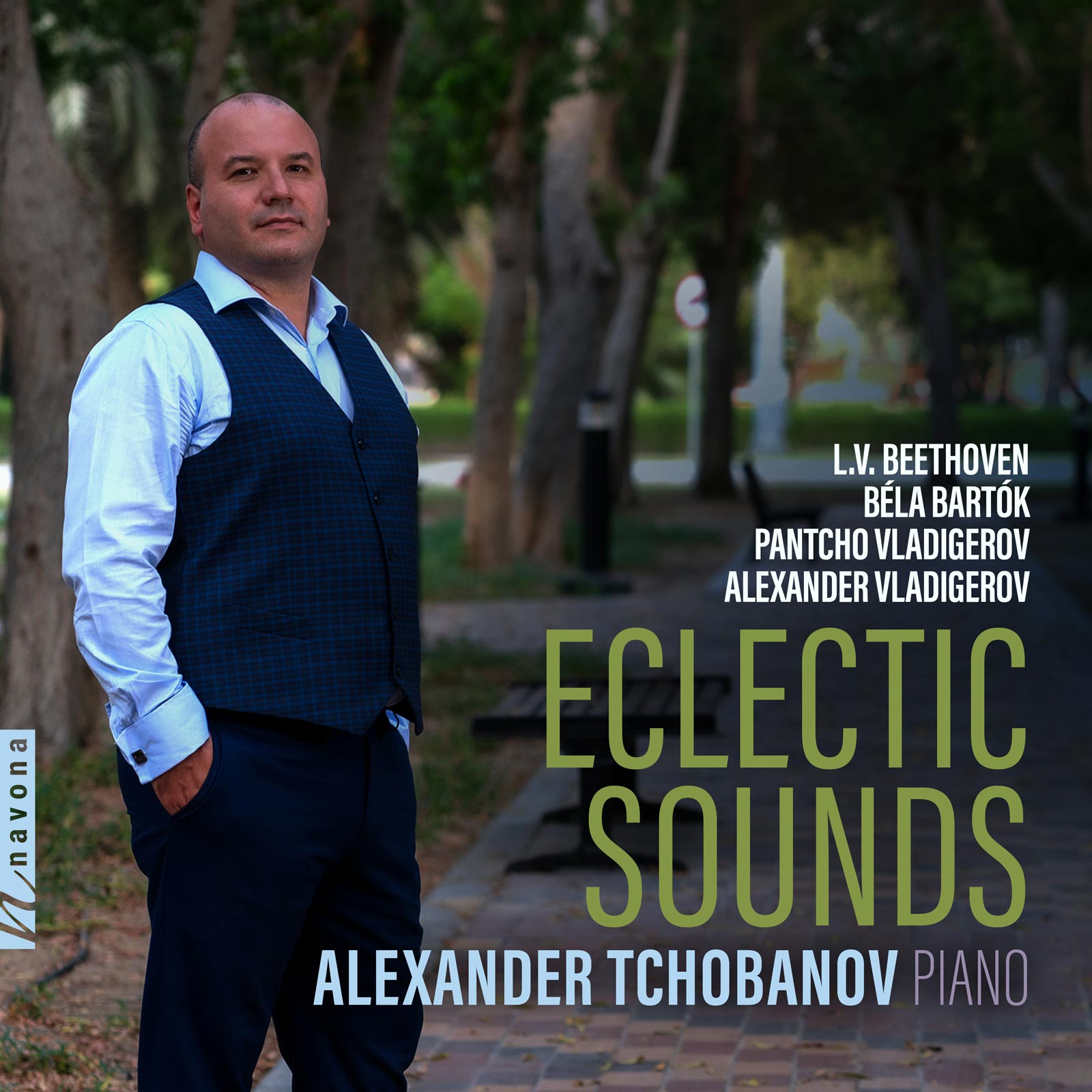Eclectic Sounds
Alexander Tchobanov piano
L.V. Beethoven composer
Béla Bartók composer
Pantcho Vladigerov composer
Alexander Vladigerov composer
What do Beethoven, Bartók and Bulgaria’s national composer Vladigerov have in common? This is the question posed by Bulgarian pianist Alexander Tchobanov on his new album ECLECTIC SOUNDS – and what appears to be a harmless question soon turns into a mighty quest.
Contrasting Beethoven’s Piano Sonata No. 30, a selection of beloved works by Bartók as well as two pieces composed by a Vladigerov – one by the father, one by his son -, the answer is quickly elucidated: the common denominator between these works is their inner drive, their lucidity, their monumental precision. Performed with an ambitious blend of vigor and exactitude, Tchobanov unveils their inner workings with previously-unheard, razor-sharp clarity.
Listen
Stream/Buy
Choose your platform
Track Listing & Credits
| # | Title | Composer | Performer | |
|---|---|---|---|---|
| 01 | Sonata No. 30 Op. 109: I. Vivace, Adagio Espressivo | Ludwig van Beethoven | Alexander Tchobanov, piano | 3:33 |
| 02 | Sonata No. 30 Op. 109: II. Prestissimo | Ludwig van Beethoven | Alexander Tchobanov, piano | 2:22 |
| 03 | Sonata No. 30 Op. 109: III. Andante Molto Cantabile ed Espressivo | Ludwig van Beethoven | Alexander Tchobanov, piano | 12:23 |
| 04 | Sonata Sz. 80: I. Allegro Moderato | Béla Bartók | Alexander Tchobanov, piano | 4:05 |
| 05 | Sonata Sz. 80: II. Sostenuto e Pesante | Béla Bartók | Alexander Tchobanov, piano | 4:20 |
| 06 | Sonata Sz. 80: III. Allegro Molto | Béla Bartók | Alexander Tchobanov, piano | 3:19 |
| 07 | Six Dances in Bulgarian Rhythm for piano from "Mikrokosmos" | Béla Bartók | Alexander Tchobanov, piano | 8:40 |
| 08 | Piano Pieces op.15 No.1 Prelude | Pantcho Vladigerov | Alexander Tchobanov, piano | 4:53 |
| 09 | Dilmano Dilbero Variations op. 2 | Alexander Vladigerov | Alexander Tchobanov, piano | 9:04 |
Recorded July 12-14, 2021, February 11 & 13, 2022 at Runiton Musicstore in Plovdiv, Bulgaria
Recording Engineer Vasil Valtchev
Recorded on a Steingraeber & Söhne piano
Photos by Jonathan Penunia
Acknowledgements
The album is dedicated to my mother Eva Boyadjieva (my biggest fan and supporter), my wife Pamela, and my son Adrian.
In memory of my father Krastuy Chobanov (1943-2022)
– Alexander Tchobanov
Executive Producer Bob Lord
A&R Director Brandon MacNeil
A&R Chris Robinson
VP of Production Jan Košulič
Audio Director Lucas Paquette
VP, Design & Marketing Brett Picknell
Art Director Ryan Harrison
Design Edward A. Fleming, Morgan Hauber
Publicity Patrick Niland, Aidan Curran
Artist Information

Alexander Tchobanov
Alexander Tchobanov has gained international recognition as a concert pianist, recording artist, chamber musician, and music pedagogue. Following his 2013 Carnegie Hall solo debut, the New York Concert Review wrote, “Mr. Tchobanov's colors and voicing were superb, creating that ineffable aura of Russian sadness we love so much, there is a major virtuoso there.” He was invited to perform at major international venues and festivals such as Jordan Hall in Boston, Steinway Hall in New York, Los Angeles Music Center, Manila Piano Artist Series, Auersperg Palace in Vienna, Madinat Theater in Dubai, International Piano Festival “Krystian Tkaczewski’’ in Poland, and CME Concerto Fest among others. Tchobanov's recordings of works by Scriabin and Rachmaninoff are commercially available on the Ulysses Arts label. He was featured as a soloist with Vienna Residence Orchestra and Tarnow Chamber Orchestra.

